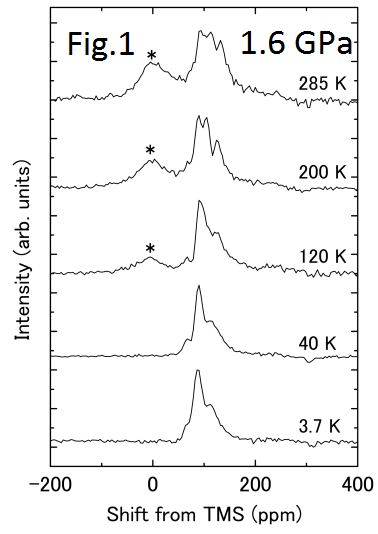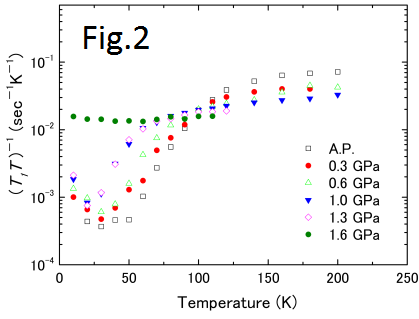Topics
- Superconducting fluctuations in κ-(BEDT-TTF)2Cu[N(CN)2]Br
- Commensurability of SDW in (TMTSF)2PF6
- Charge ordered state in β''-(BEDT-TTF)3Cl2⋅2H2O
- Correlation between non-Fermi-liquid behavior and anti-ferromagnetic fluctuation in (TMTSF)2PF6
- Low-frequency dynamics of κ-(BEDT-TTF)2Cu(NCS)2
- Zero-gap-semiconductor state of α-(BEDT-TTF)2I3
The organic conductor β''-(BEDT-TTF)3Cl2⋅2H2O shows superconductivity under pressures, whereas the salt exhibits metal-insulator transition (MIT) at ambient pressure. It is suggested that the mechanism of superconductivity relate to some instability of the insulating phase in this salt because the superconducting phase is adjacent to the insulating phase. We have investigated the properties of the insulating phase and the metallic phase just above superconducting transition temperature (Tc) by 13C-NMR measurement.
The insulating phase
The MIT was believed to originate from a charge density wave (CDW) formation by the nesting of conducting bands because its Fermi surface if one-dimensional. In general, a CDW occurs with a modification of the crystal structure. However, X-ray experiments by J. Gaultier et al. showed that the MIT was not accompanied by a modification of the crystal structure. The results of the optical measurement by T. Yamamoto et al. suggested that a charge order (CO), which is caused by the effective on-site and off-site Coulomb repulsive energy, occurs in the insulating phase. We measured the NMR spectrum and found the following two points:
- Not the CDW but the CO with some symmetry breaking occurs in the insulating phase.
- The charges on the three sites of the CO state are estimated as ~+0.4e, ~+0.6e, and ~+1.0e and its abundance ratio is estimated as 2:3:1.
The metallic phase just above Tc
The result of the Raman scattering by T. Yamamoto et al. suggested that charge inhomogeneity remained at the critical pressure of superconductivity and low temperature. The NMR spectrum (Fig. 1) and the spin-lattice relaxation time (T1 : Fig. 2) that we measured suggest that the gap behavior suddenly disappears and the charge disproportionation changes with temperature at 1.6 GPa where superconductivity occurs. These results suggest that the charge disproportionation keeps developing until superconductivity sets in. We propose that the charge disproportionation and superconductivity coexist at low temperatures.
The paper titled g13C-NMR studies of the paramagnetic and charge-ordered states of the organic superconductor β''-(BEDT-TTF)3Cl2⋅2H2O under pressureh has been published in Phys. Rev. B 85, 035105 (2011).

